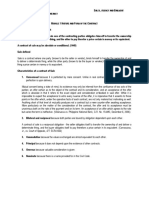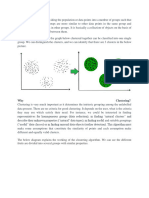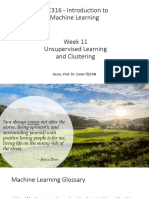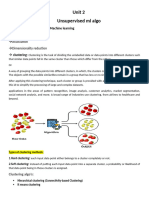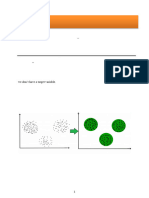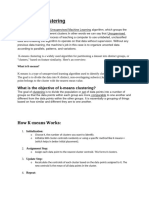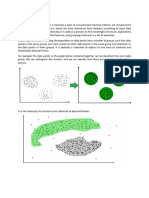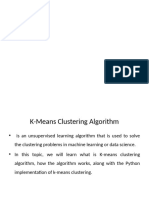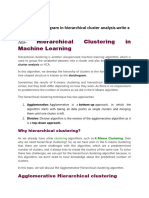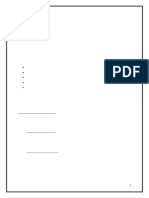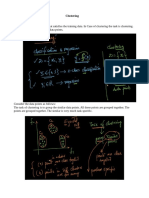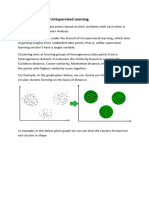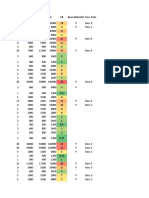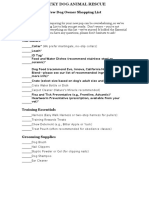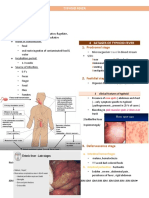Unit Iv
Unit Iv
Uploaded by
manglamdubey2011Copyright:
Available Formats
Unit Iv
Unit Iv
Uploaded by
manglamdubey2011Original Title
Copyright
Available Formats
Share this document
Did you find this document useful?
Is this content inappropriate?
Copyright:
Available Formats
Unit Iv
Unit Iv
Uploaded by
manglamdubey2011Copyright:
Available Formats
AIML – UNIT IV
Clustering in Machine Learning
Clustering or cluster analysis is a machine learning technique, which groups the unlabelled dataset. It can be
defined as "A way of grouping the data points into different clusters, consisting of similar data
points. The objects with the possible similarities remain in a group that has less or no
similarities with another group."
It does it by finding some similar patterns in the unlabelled dataset such as shape, size, color, behavior, etc.,
and divides them as per the presence and absence of those similar patterns.
It is an unsupervised learning method, hence no supervision is provided to the algorithm, and it deals with
the unlabeled dataset.
After applying this clustering technique, each cluster or group is provided with a cluster-ID. ML system can
use this id to simplify the processing of large and complex datasets.
Example: Let's understand the clustering technique with the real-world example of Mall: When we visit any
shopping mall, we can observe that the things with similar usage are grouped together. Such as the t-shirts
are grouped in one section, and trousers are at other sections, similarly, at vegetable sections, apples,
bananas, Mangoes, etc., are grouped in separate sections, so that we can easily find out the things. The
clustering technique also works in the same way. Other examples of clustering are grouping documents
according to the topic.
The clustering technique can be widely used in various tasks. Some most common uses of this technique
are:
o Market Segmentation
o Statistical data analysis
o Social network analysis
o Image segmentation
o Anomaly detection, etc.
Apart from these general usages, it is used by the Amazon in its recommendation system to provide the
recommendations as per the past search of products. Netflix also uses this technique to recommend the
movies and web-series to its users as per the watch history.
The below diagram explains the working of the clustering algorithm. We can see the different fruits are
divided into several groups with similar properties.
By Dr. Megha Mishra
AIML – UNIT IV
Types of Clustering Methods
The clustering methods are broadly divided into Hard clustering (datapoint belongs to only one group)
and Soft Clustering (data points can belong to another group also). But there are also other various
approaches of Clustering exist. Below are the main clustering methods used in Machine learning:
1. Partitioning Clustering
2. Density-Based Clustering
3. Distribution Model-Based Clustering
4. Hierarchical Clustering
5. Fuzzy Clustering
Partitioning Clustering
It is a type of clustering that divides the data into non-hierarchical groups. It is also known as the centroid-
based method. The most common example of partitioning clustering is the K-Means Clustering
algorithm
In this type, the dataset is divided into a set of k groups, where K is used to define the number of pre-defined
groups. The cluster center is created in such a way that the distance between the data points of one cluster
is minimum as compared to another cluster centroid.
K-Means Clustering Algorithm
K-Means Clustering is an unsupervised learning algorithm that is used to solve the clustering problems in
machine learning or data science. In this topic, we will learn what is K-means clustering algorithm, how the
algorithm works, along with the Python implementation of k-means clustering.
What is K-Means Algorithm?
K-Means Clustering is an Unsupervised Learning algorithm , which groups the unlabeled dataset into
different clusters. Here K defines the number of pre-defined clusters that need to be created in the process,
as if K=2, there will be two clusters, and for K=3, there will be three clusters, and so on. It is an iterative
algorithm that divides the unlabeled dataset into k different clusters in such a way that each dataset belongs only one group that
has similar properties.
By Dr. Megha Mishra
AIML – UNIT IV
It allows us to cluster the data into different groups and a convenient way to discover the categories of
groups in the unlabeled dataset on its own without the need for any training.
It is a centroid-based algorithm, where each cluster is associated with a centroid. The main aim of this
algorithm is to minimize the sum of distances between the data point and their corresponding clusters.
The algorithm takes the unlabeled dataset as input, divides the dataset into k-number of clusters, and
repeats the process until it does not find the best clusters. The value of k should be predetermined in this
algorithm.
The k-means clustering
algorithm mainly performs two tasks:
o Determines the best value for K center points or centroids by an iterative process.
o Assigns each data point to its closest k-center. Those data points which are near to the particular k-
center, create a cluster.
Hence each cluster has datapoints with some commonalities, and it is away from other clusters.
The below diagram explains the working of the K-means Clustering Algorithm:
How does the K-Means Algorithm Work?
The working of the K-Means algorithm is explained in the below steps:
Step-1: Select the number K to decide the number of clusters.
Step-2: Select random K points or centroids. (It can be other from the input dataset).
Step-3: Assign each data point to their closest centroid, which will form the predefined K clusters.
Step-4: Calculate the variance and place a new centroid of each cluster.
By Dr. Megha Mishra
AIML – UNIT IV
Step-5: Repeat the third steps, which means reassign each datapoint to the new closest centroid of each
cluster.
Step-6: If any reassignment occurs, then go to step-4 else go to FINISH.
Step-7: The model is ready.
Let's understand the above steps by considering the visual plots:
Suppose we have two variables M1 and M2. The x-y axis scatter plot of these two variables is given below:
o Let's take number k of clusters, i.e., K=2, to identify the dataset and to put them into different
clusters. It means here we will try to group these datasets into two different clusters.
o We need to choose some random k points or centroid to form the cluster. These points can be either
the points from the dataset or any other point. So, here we are selecting the below two points as k
points, which are not the part of our dataset. Consider the below image:
By Dr. Megha Mishra
AIML – UNIT IV
o Now we will assign each data point of the scatter plot to its closest K-point or centroid. We will
compute it by applying some mathematics that we have studied to calculate the distance between
two points. So, we will draw a median between both the centroids. Consider the below image:
o
From the above image, it is clear that points left side of the line is near to the K1 or blue centroid, and points
to the right of the line are close to the yellow centroid. Let's color them as blue and yellow for clear
visualization.
By Dr. Megha Mishra
AIML – UNIT IV
o As we need to find the closest cluster, so we will repeat the process by choosing a new centroid.
To choose the new centroids, we will compute the center of gravity of these centroids, and will find
new centroids as below:
o Next, we will reassign each datapoint to the new centroid. For this, we will repeat the same process
of finding a median line. The median will be like below image:
From the above image, we can see, one yellow point is on the left side of the line, and two blue points are
right to the line. So, these three points will be assigned to new centroids.
By Dr. Megha Mishra
AIML – UNIT IV
As reassignment has taken place, so we will again go to the step-4, which is finding new centroids or K-
points.
o We will repeat the process by finding the center of gravity of centroids, so the new centroids will be
as shown in the below image:
By Dr. Megha Mishra
AIML – UNIT IV
o As we got the new centroids so again will draw the median line and reassign the data points. So, the
image will be:
o We can see in the above image; there are no dissimilar data points on either side of the line, which
means our model is formed. Consider the below image:
As our model is ready, so we can now remove the assumed centroids, and the two final clusters will be as
shown in the below image:
By Dr. Megha Mishra
AIML – UNIT IV
K-Medoids clustering
-Medoids (also called Partitioning Around Medoid) algorithm was proposed in 1987 by Kaufman and
Rousseeuw. A medoid can be defined as a point in the cluster, whose dissimilarities with all the other points
in the cluster are minimum. The dissimilarity of the medoid(Ci) and object(Pi) is calculated by using E = |Pi –
Ci|
The cost in K-Medoids algorithm is given as
Algorithm:
1. Initialize: select k random points out of the n data points as the medoids.
2. Associate each data point to the closest medoid by using any common distance metric methods.
3. While the cost decreases: For each medoid m, for each data o point which is not a medoid:
Swap m and o, associate each data point to the closest medoid, and recompute the cost.
If the total cost is more than that in the previous step, undo the swap.
By Dr. Megha Mishra
AIML – UNIT IV
Let’s consider the following example: If a graph is drawn using the above data points, we obtain the
following:
Step 1: Let the randomly selected 2 medoids, so select k = 2, and let C1 -(4, 5) and C2 -(8, 5) are the two
medoids.
Step 2: Calculating cost. The dissimilarity of each non-medoid point with the medoids is calculated and
tabulated:
By Dr. Megha Mishra
AIML – UNIT IV
Here we have used Manhattan distance formula to calculate the distance matrices between medoid and
non-medoid points. That formula tell that Distance = |X1-X2| + |Y1-Y2|.
Each point is assigned to the cluster of that medoid whose dissimilarity is less. Points 1, 2, and 5 go to cluster C1
and 0, 3, 6, 7, 8 go to cluster C2. The Cost = (3 + 4 + 4) + (3 + 1 + 1 + 2 + 2) = 20
Step 3: randomly select one non-medoid point and recalculate the cost. Let the randomly selected point be
(8, 4). The dissimilarity of each non-medoid point with the medoids – C1 (4, 5) and C2 (8, 4) is calculated and
tabulated.
Each point is assigned to that cluster whose dissimilarity is less. So, points 1, 2, and 5 go to cluster C1 and 0, 3, 6,
7, 8 go to cluster C2. The New cost = (3 + 4 + 4) + (2 + 2 + 1 + 3 + 3) = 22 Swap Cost = New Cost – Previous Cost
= 22 – 20 and 2 >0 As the swap cost is not less than zero, we undo the swap. Hence (4, 5) and (8, 5) are the final
medoids. The clustering would be in the following way The time complexity is o(k*(n-k)2)
By Dr. Megha Mishra
AIML – UNIT IV
Advantages:
1. It is simple to understand and easy to implement.
2. K-Medoid Algorithm is fast and converges in a fixed number of steps.
3. PAM is less sensitive to outliers than other partitioning algorithms.
Disadvantages:
1. The main disadvantage of K-Medoid algorithms is that it is not suitable for clustering non-spherical
(arbitrarily shaped) groups of objects. This is because it relies on minimizing the distances between the non-
medoid objects and the medoid (the cluster center) – briefly, it uses compactness as clustering criteria instead
of connectivity.
2. It may obtain different results for different runs on the same dataset because the first k medoids are
chosen randomly.
By Dr. Megha Mishra
You might also like
- Valenzuela, Luisa - The Lizard's Tail (1987, Serpent's Tail, 1852421126,9781852421120)Document147 pagesValenzuela, Luisa - The Lizard's Tail (1987, Serpent's Tail, 1852421126,9781852421120)acs31No ratings yet
- Image Segmentation Using K Mean AlgorithmDocument5 pagesImage Segmentation Using K Mean AlgorithmYonsNo ratings yet
- Statics of Rigid Bodies ChaptersDocument34 pagesStatics of Rigid Bodies ChaptersDeniell Kahlil Kyro Gabon100% (1)
- Module 1 Nature and Form of The ContractDocument30 pagesModule 1 Nature and Form of The Contractcha11100% (1)
- Unit 3 DataDocument37 pagesUnit 3 DataSangamNo ratings yet
- ClusteringDocument24 pagesClustering1138 Anuj BhowmickNo ratings yet
- ClusteringDocument10 pagesClusteringSaif FazalNo ratings yet
- ClusteringDocument17 pagesClusteringAatri PalNo ratings yet
- KMeans ClusteringDocument16 pagesKMeans ClusteringBasant KothariNo ratings yet
- Clustering_notesDocument29 pagesClustering_notesyuvrajsharma56780No ratings yet
- Unit 3 & 4 (p18)Document18 pagesUnit 3 & 4 (p18)Kashif BaigNo ratings yet
- Aiml Unit 4Document20 pagesAiml Unit 4kanishNo ratings yet
- UNIT 4 K-Means ClustringDocument13 pagesUNIT 4 K-Means Clustringsahil.utube2003No ratings yet
- DWDM Unit5Document14 pagesDWDM Unit5sri charanNo ratings yet
- Unit 4 AamDocument26 pagesUnit 4 Aamdavidhackwell531No ratings yet
- 7.introduction To ClusteringDocument11 pages7.introduction To ClusteringGavi KiranNo ratings yet
- Unit IVDocument96 pagesUnit IVSai ManasaNo ratings yet
- UNIT - 3 - ClusteringDocument21 pagesUNIT - 3 - ClusteringDev GoyalNo ratings yet
- Week 11Document49 pagesWeek 11SvipDagNo ratings yet
- Text Analytics Unit-3Document11 pagesText Analytics Unit-3aathyukthas.ai20001No ratings yet
- K MeanDocument12 pagesK MeanShivram DwivediNo ratings yet
- K Means Clustering AlgorithmDocument12 pagesK Means Clustering Algorithmnandanvarma.dandu9No ratings yet
- unsupervised learningDocument23 pagesunsupervised learningshaukeenkha3606No ratings yet
- ML UNIT 2Document17 pagesML UNIT 2kmwtkuldeep1No ratings yet
- K-Mean ClusteringDocument8 pagesK-Mean Clusteringhokijic810No ratings yet
- DSV_Unit 3_Data Analysis in DepthDocument53 pagesDSV_Unit 3_Data Analysis in Depth27 03No ratings yet
- MACHINE LEARNING NOTES ANNA UNIVERSITYDocument14 pagesMACHINE LEARNING NOTES ANNA UNIVERSITYJeeva JeevaNo ratings yet
- K MeanDocument7 pagesK MeanDeergha TiwariNo ratings yet
- ML Unit-4Document14 pagesML Unit-4sampathmandru18No ratings yet
- ML Unit 2 NotesDocument14 pagesML Unit 2 Notesskmirajulislam181No ratings yet
- Machine LearningDocument23 pagesMachine LearningKeertana RNo ratings yet
- K-Means Clustering Algorithm - JavatpointDocument21 pagesK-Means Clustering Algorithm - Javatpointmangotwin22No ratings yet
- Unit 4Document40 pagesUnit 4cs235214205No ratings yet
- Presentation 1Document47 pagesPresentation 1mamehasen2015No ratings yet
- K - Mean ClusteringDocument12 pagesK - Mean ClusteringShuvajit Das amitNo ratings yet
- Unit 3 Updated NotesDocument29 pagesUnit 3 Updated Notesabhishekilindra2021No ratings yet
- Artificial Intelligence ReportDocument23 pagesArtificial Intelligence ReportJoan EbordeNo ratings yet
- ML Unit 5Document50 pagesML Unit 5SUJATA SONWANENo ratings yet
- Hierarchical Clustering - 11.3.2024 - FullDocument14 pagesHierarchical Clustering - 11.3.2024 - Full0707thecaptaincoolNo ratings yet
- Machine Learning Bloque 4Document12 pagesMachine Learning Bloque 4Alba MoralesNo ratings yet
- K Means ClusteringDocument6 pagesK Means ClusteringAlina Corina BalaNo ratings yet
- K-Means ClusteringDocument5 pagesK-Means ClusteringManiNo ratings yet
- Lecture Notes - ClusteringDocument13 pagesLecture Notes - Clusteringgunjan BhardwajNo ratings yet
- Lecture+Notes+ +clusteringDocument13 pagesLecture+Notes+ +clusteringPankaj PandeyNo ratings yet
- Working of K Means Algorithm - YashBhureDocument14 pagesWorking of K Means Algorithm - YashBhureYash BhureNo ratings yet
- Unit 5 - Cluster AnalysisDocument14 pagesUnit 5 - Cluster Analysiseskpg066No ratings yet
- Data Analytics and Model EvaluationDocument55 pagesData Analytics and Model Evaluationtoon townNo ratings yet
- Techniques of Cluster Analysis: A Seminar OnDocument25 pagesTechniques of Cluster Analysis: A Seminar OnVAIBHAV NANAWARENo ratings yet
- K-Means ClusteringDocument8 pagesK-Means ClusteringAbeer PareekNo ratings yet
- ML_unit_4Document17 pagesML_unit_4Durga Bhavani AlankaNo ratings yet
- Distance-Based Methods - KNNDocument8 pagesDistance-Based Methods - KNNshreya sarkarNo ratings yet
- Digital Image Processing: Segmentation-5Document43 pagesDigital Image Processing: Segmentation-5hamzaNo ratings yet
- Unit-4 (2)Document29 pagesUnit-4 (2)Krishna RaoNo ratings yet
- Foml - U3Document32 pagesFoml - U3top techi tamizhaNo ratings yet
- Hierarchical Clustering: Required DataDocument6 pagesHierarchical Clustering: Required DataHritik AgrawalNo ratings yet
- K-Means ClusteringDocument6 pagesK-Means ClusteringdatasciencetrainingnucotNo ratings yet
- U1 - KMeans - 5th Sem - DSDocument14 pagesU1 - KMeans - 5th Sem - DSsubbumail051No ratings yet
- ClusteringDocument28 pagesClusteringprabhakaran sridharanNo ratings yet
- WWW Simplilearn Com Tutorials Machine Learning Tutorial K Means Clustering AlgorDocument19 pagesWWW Simplilearn Com Tutorials Machine Learning Tutorial K Means Clustering Algoranees shahidNo ratings yet
- UNIT IVDocument19 pagesUNIT IVapdeshmukh371122No ratings yet
- ML_Lec-16Document16 pagesML_Lec-16bhargavr3103No ratings yet
- Techniques of Cluster Analysis: A Seminar OnDocument25 pagesTechniques of Cluster Analysis: A Seminar OnVAIBHAV NANAWARENo ratings yet
- Baluchistan Black Bear: Scientific ClassificationDocument3 pagesBaluchistan Black Bear: Scientific ClassificationRoshan PMNo ratings yet
- SITXFSA004 Assessment 1 AssignmentDocument11 pagesSITXFSA004 Assessment 1 AssignmentkarthikNo ratings yet
- CR750-CR751 Controller Troubleshooting Bfp-A8871pDocument72 pagesCR750-CR751 Controller Troubleshooting Bfp-A8871pBarry Weller100% (1)
- An-42007 AN42007 Safety, EMI and RFI ConsiderationsDocument6 pagesAn-42007 AN42007 Safety, EMI and RFI ConsiderationsSunu PradanaNo ratings yet
- Engine Testing and Rating: Standardized Gasoline TestsDocument32 pagesEngine Testing and Rating: Standardized Gasoline TestsJahmia CoralieNo ratings yet
- MetabolismDocument21 pagesMetabolismNagendra NayakNo ratings yet
- Mila Amor V. Reyes, MD, FPSP Anatomic and Clinical PathologistDocument41 pagesMila Amor V. Reyes, MD, FPSP Anatomic and Clinical PathologistFranco Rommel ReyesNo ratings yet
- AryabhataDocument4 pagesAryabhataIsmail MswNo ratings yet
- Elder Evils MonstersDocument31 pagesElder Evils MonstersJon GilliamNo ratings yet
- Installation Guide For Cisco ACSDocument8 pagesInstallation Guide For Cisco ACSsomeoneniceNo ratings yet
- Statue of Liberty LPDocument4 pagesStatue of Liberty LPapi-271869316No ratings yet
- LD New Dog Shopping ListDocument2 pagesLD New Dog Shopping ListAbdullah TheNo ratings yet
- 4~6 올림포스+독해의+기본+2Document24 pages4~6 올림포스+독해의+기본+2shingal.s230285No ratings yet
- Thesis Synopsis & Proposal Healing ArchitectureDocument4 pagesThesis Synopsis & Proposal Healing ArchitectureAbinaya Varma0% (1)
- Danfoss Service Guide F Frame MG90K302Document211 pagesDanfoss Service Guide F Frame MG90K302jose eduardo cruz hernandezNo ratings yet
- 7.3.1.2 Packet Tracer Simulation - Exploration of TCP andDocument6 pages7.3.1.2 Packet Tracer Simulation - Exploration of TCP andALCHISENo ratings yet
- Beyond Greening: Strategies For A Sustainable World: Harvard Business ReviewDocument12 pagesBeyond Greening: Strategies For A Sustainable World: Harvard Business Reviewmaneesha srinivasNo ratings yet
- INST232 Sec1Document99 pagesINST232 Sec1Herman DamanikNo ratings yet
- LP12 180Document2 pagesLP12 180brobataNo ratings yet
- AVTBall ButterflyTechnicalBinderDocument52 pagesAVTBall ButterflyTechnicalBindermohdnazirNo ratings yet
- Formula SheetDocument1 pageFormula SheetHabeba EmadNo ratings yet
- NCMB 312 Finals! (2.0)Document25 pagesNCMB 312 Finals! (2.0)Justine Dinice MunozNo ratings yet
- 13 B Biodeterioration ModifiedDocument7 pages13 B Biodeterioration ModifiedAradhanaNo ratings yet
- Prof. Varsha Tank (IT/ICT Dept. - Ljiet) : Presented byDocument13 pagesProf. Varsha Tank (IT/ICT Dept. - Ljiet) : Presented by6001vaibhav KoratNo ratings yet
- CSE 3320: Operating Systems: CPU SchedulingDocument28 pagesCSE 3320: Operating Systems: CPU Schedulingpalashcse08No ratings yet
- Failure Rate On Repair CostsDocument5 pagesFailure Rate On Repair CostsDemelash GindoNo ratings yet
- Epa 5Document28 pagesEpa 5janfarsa9623No ratings yet



